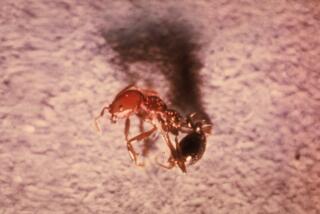State Finds 5 Medflies in Santa Ana : Agriculture: Malathion spraying is to begin today in the area of McFadden and Standard avenues.
SANTA ANA — State work crews today will begin spraying malathion over ground foliage near the intersection of McFadden and Standard avenues in Santa Ana after five male Medflies were found there Thursday in a peach tree.
It was the second Medfly infestation in Orange County this year. There were 28 Medflies found between June 30 and Aug. 8 in Westminster, about six miles west of the Santa Ana site.
“It’s becoming a pretty routine thing almost,” said Carl DeWing, communications officer for the California Department of Food and Agriculture.
However, DeWing added, “the infestations we’ve had this year have all been relatively small, concentrated.” State officials worry that a broad infestation of mature Mediterranean fruit flies could pose severe harm to Southland agriculture.
Trappers in Santa Ana found three sexually immature Medflies and two other male flies whose maturity could not be determined because of their decayed condition.
The fact that at least three of the flies found Thursday were immature “means we’ve caught this infestation early,” DeWing said. “If we found a mature mated female with eggs, that would raise a lot of red flags.”
A Medfly’s life span during the summer is about 30 days, DeWing said.
After Thursday’s discovery, Medfly project officials stepped up their fruit cutting and placements of traps in the Santa Ana neighborhood as workers searched for larvae and more flies. Five additional flies were discovered and sent to Sacramento for testing Thursday, but it is not yet known whether they are in fact Medflies.
Meanwhile, state workers increased the number of 8-inch by 12-inch sticky panel traps, featuring “sexual lures,” to a rate of about 1,000 traps per square mile within the area around the Santa Ana finds.
By next week, quarantine boundaries will also be drawn in Santa Ana to prevent the spread of the infestation, DeWing said. The area of quarantine normally is about 81 square miles.
A 65-square-mile quarantine area already is in effect as a result of the earlier discovery of Medflies, covering the city of Westminster and nine adjacent Orange County communities.
“We are asking the residents down there to please not move the food off their property because it might spread the Medflies,” DeWing said.
DeWing assured residents that the ground spraying does not pose a hazard.
During the spraying, “residents do not have to leave their homes. . . . It’s the same malathion that people use in their back-yard gardens,” he said.
The spray that will be applied today in a 200-meter radius of the McFadden-Standard street intersection “is not a mist,” DeWing said. “It is only tiny droplets that only go to the areas we spray it to.”
Moreover, workers are instructed to be careful to avoid open windows, playground equipment and pet dishes, he said.
State officials have not had to resort to aerial spraying since 1990, when thousands of residents around the area turned out to protest the state’s method of attack. Challenging the state’s finding, environmentalists and other critics maintained the spraying was unsafe.
Aerial spraying remains an option today, DeWing said, “but we don’t foresee that in the near future.”
A decision on whether to release thousands of sterile Medflies in Santa Ana to eradicate the problem is pending, DeWing said. About 26 million sterile flies a week have been released in the Westminster area since the discovery of Medflies there.
Residents who discover Medflies are urged to telephone the Medfly project at (800) 491-1899.
More to Read
Sign up for Essential California
The most important California stories and recommendations in your inbox every morning.
You may occasionally receive promotional content from the Los Angeles Times.










